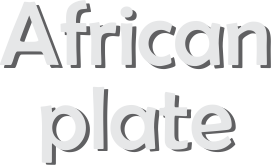
The African Plate is a major tectonic division of the earth’s crust, which includes the African continent as the linear ocean basins, namely, the Canary, Cape Verde, Angola, Cape Agulhas, Somali, Madagascar, and Natal Basins. It borders the Eurasian and Arabian Plates to the north, the mid-ocean ridges including the Southwest Indian, Mid-Ocean and Carlsberg Ridges on the east, the Mid-Atlantic Ridge on the west and the Antarctic Plate on the south.
About 400 million years ago, when Pangaea was the only supercontinent, Africa was at its centre. The continents are mostly made of thick granite. For plate tectonics, when continents pull apart, it is just any piece of continental crust which is surrounded by the oceanic crust or the plate boundaries. Later, about 120 million years ago, Africa and eastern Gondwanaland, which included India, Antarctica and Australia, separated. As the crust broke on the eastern side of Madagascar, it was left attached to the African Plate. Africa continued to break and it is generally believed that the African Rift Valley, which finishes in the southern Africa, to be a separate plate but many regard Africa as a plate which was in the process of splitting in two. Numerous small plates that were originally attached to the Mediterranean coast of Africa about 150 million years ago broke off and collided with Europe to create the Alps and other mountain ranges. Later, around 6 million years ago, a mountain barrier was raised and Mediterranean was cut off from the Atlantic when Africa collided with Spain.

Out of all the seven major plates, the African Plate and the Pacific Plate are the biggest. The Plate is about 61,300,000 km in size. Moving in the northeast direction over the past 100 million years, the estimated speed of the African Plate is around 2.15 cm a year.
Several cratons, stable blocks of old crust with deep roots in the subcontinental lithospheric mantle, and comparatively less stable terranes together formed the African Plate. Most of the scientists believe that Europe could move beneath Africa as the two continents shift closer because the northern edge of the African Tectonic Plate has descended under Europe for millions of years but it has been reported that this process is halted.
There are very few submount plates on the African Plate. However, there are volcanoes on land indeed. Few of them include:
- Kilimanjaro in Tanzania with a height of about 19,336 feet.
- Kieyo in Tanzania with a height of around 7,136 feet.
- Oku Volcano with 9,880 feet height.
- Volcano Karisimbi at Rwanda rising to a height of about 14,787 feet.


